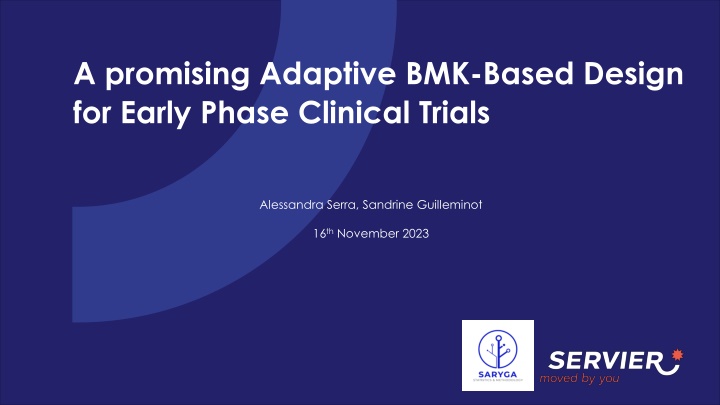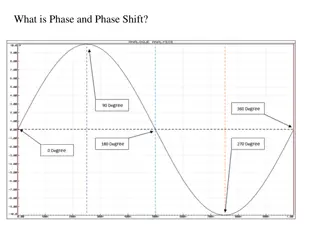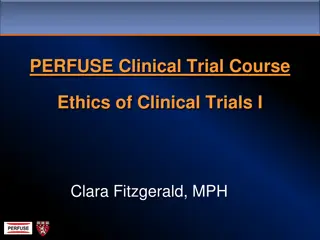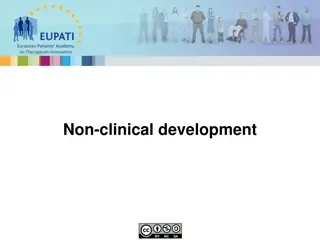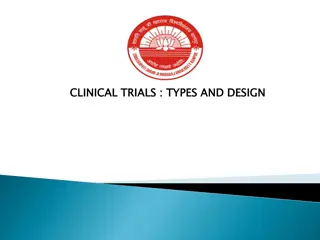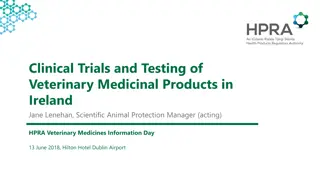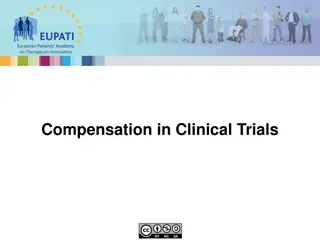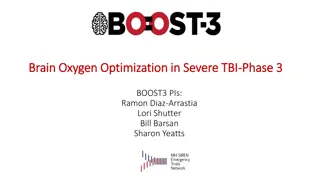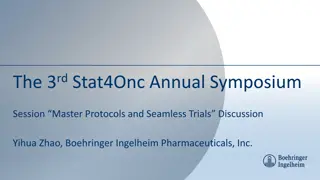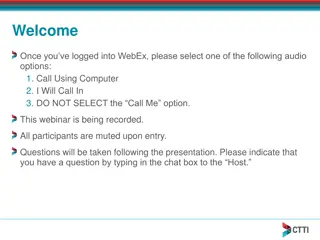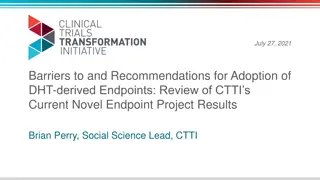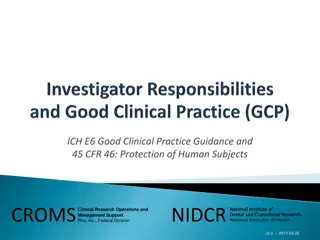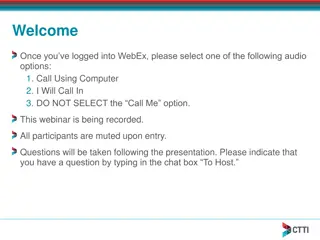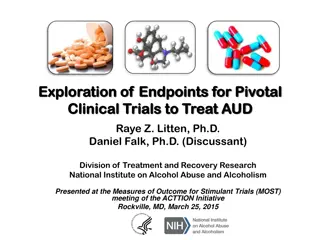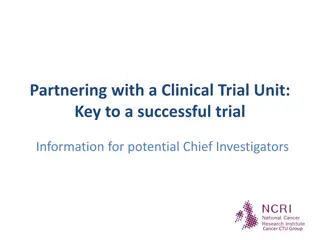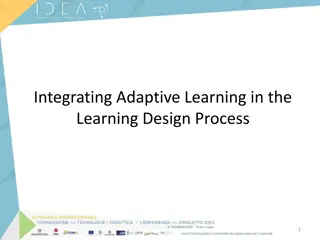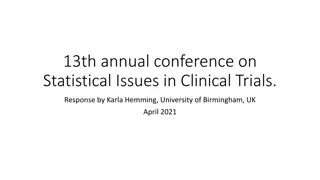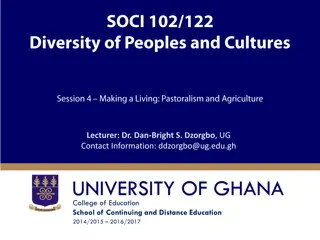Promising Adaptive BMK-Based Design for Early Phase Clinical Trials
A design proposal for early phase clinical trials aiming to quickly establish the worth of a drug for further pursuit in overall indication or biomarker subgroup. The study focuses on enriching BMK+ patients and minimizing the risk of missing efficacy signals through adaptive design strategies. Addressing uncertainties in predictive value, cutoff value, proportion of BMK+ patients, and treatment effect magnitude, the proposal suggests an interim analysis enrichment strategy based on robust biomarker cutoff findings.
Uploaded on Sep 17, 2024 | 0 Views
Download Presentation

Please find below an Image/Link to download the presentation.
The content on the website is provided AS IS for your information and personal use only. It may not be sold, licensed, or shared on other websites without obtaining consent from the author.If you encounter any issues during the download, it is possible that the publisher has removed the file from their server.
You are allowed to download the files provided on this website for personal or commercial use, subject to the condition that they are used lawfully. All files are the property of their respective owners.
The content on the website is provided AS IS for your information and personal use only. It may not be sold, licensed, or shared on other websites without obtaining consent from the author.
E N D
Presentation Transcript
A promising Adaptive BMK-Based Design for Early Phase Clinical Trials Alessandra Serra, Sandrine Guilleminot 16thNovember 2023
Motivation Goal: Quickly establish that the drug is worth pursuing further, on the overall indication or in a biomarker subgroup PoC Approval Traditional development journey Ph I Dose Escalation Ph III +/-Post Marketing Request Ph Ib Expansion Ph II Trial Registration trial Putative BMK predictive of treatment responses - Measured on a continuous scale - No predefined cutoff for BMK+ patients Enrich on BMK + or not ? No, lack of evidence in patients to support BMK hypothesis Yes, to avoid the risk of missing an efficacy signal PoC = Proof of Concept 2
Motivation - Dont Miss a Signal Option 3 Option 2 Option 1 ADAPTIVE DESIGN BMK Enrichment at the interim stage of the study Enrichment Fixed Design No Enrichment Fixed Design BMK Enrichment at the beginning of the study BMK assessed at the end of the study Risk of missing a signal when the cutoff of the BMK is not well established + Cannot establish that the BMK-neg patients do not respond + Longer recruitment duration Risk of missing a signal when treatment benefit is limited to a small BMK+ subgroup AD offers more power than the non-AD for detecting an effect in a BMK+ subgroup 3
Many uncertainties at this early stage Uncertainties about : The predictive value of the BMK The cutoff value of the BMK used to identify patients in the BMK+ subgroup The proportion of patients who are in the BMK+ subgroup The magnitude of the treatment effect in patients BMK+ and BMK- 4
Our Design Proposal Ph Ib Expansion Interim Analysis No enrichment strategy i.e. continue as initially planned (classical design) If no robust cutoff found i.e. 1stdata not supportive of the BMK hypothesis Treatment Single-arm study Enrichment strategy i.e. recruit patients likely to respond If robust cutoff found i.e. 1stdata supportive of the BMK hypothesis Evaluation of the - Predictive value of the biomarker of interest - Robust biomarker cutoff that will guide the next recruitments Assuming: - No prognostic value of the BMK of interest (as cannot be verified in a single-arm study) - Intermediate clinical endpoint with a reasonable correlation relationship with the clinical endpoint - Preliminary analytical validation of the bioassay used to measure the BMK of interest 5
Criterion to find a robust cut-off Comparison of 3 approaches to find a robust cut-off: cut-off or no cut-off based on the following rules: 1. At least 15% of responses in at least pp% of the population; 2. Find cut-off by fitting a step function* and then see whether there are at least 15% of responses in at least pp% of the population with this cut-off value; 3. Find cut-off by fitting a step function*, check if there are at least pp% of the population above the cut-off value and declare to find cutoff if [P(p1 > p0) > diff_thr ] > p_thr. (*) Same principle (fit a step function) of (**) but with Ordinary Least Squares instead of a Bayesian model (due to convergence issues with the Bayesian model with a small sample size). Assuming to not have much prior information on the BMK-response shape of the curve and to avoid the issue of misspecified model. No other method has been used to compare this approach. The aim was initially to assess the feasibility of an adaptive enrichment design at PhI stage. (**) 6
Criterion to find a robust cut-off Figure: Probability to find a cut-off for the 3 approaches described in slide 6. The Gain is just computed as the difference between P(find cut-off|p0 = 5%, p1 = 25%) and P(find cut-off|p0 = 15%, p1 = 15%) with p0=response rate in the BMK- subgroup p1= response rate in the BMK+ subgroup Chosen approach If 80% certain that there is 10% of difference in response rate between the 2 groups in at least 10% of the population. 7
Clinical decision rules at final analysis (FA) No Go: Pr(ORR TV) 10% Go: Pr(ORR LRV) 80% Consider: Not a Go or a No Go Clinical decision rules at the interim analysis (IA) Futility: Pr(ORR LRV at FA | data at IA) < 10% Continue: Pr(ORR LRV at FA | data at IA) 10% BMK-guided design - proposal Efficacy at IA Cut-off defined from step function With at least 10% pop in BMK+ subgroup P[BMK+- BMK-> 10%] 80% Yes No BMK cutoff ? P(ORR LRV at FA| data at IA) in Full pop P(ORR LRV at FA| data at IA) in Full pop < 10% Stop for futility 10% Continue in full pop < 90% Check BMK+ 90% Continue in full pop P(ORR LRV at FA| data at IA) in BMK+ 75% Enrich in BMK+ < 75% Stop for futility 8 Design inspired from Tandem two stage design (Antoniou et al., 2016)
Simulation setting Number of patients: N= 14 at the interim analysis (IA) and 27 at the final analysis (FA) BMK Normally distributed ~ N(3.46 , = 1.3) based on a Ph Ib expansion on a Servier project One single cutoff On/Off relationship between the BMK and the treatment response other relationships to be tested later on 9
Performance (1/3) Simulations of a better treatment effect in the BMK subgroup Gain of 6% Gain of 12% Gain of 7% Gain of 30% 0.12 0.16 0.13 0.18 0.04 0.39 0.21 0.29 0.33 0.06 0.10 0.06 0.08 0.11 0.19 0.13 0.82 0.76 0.71 0.48 0.78 0.60 0.78 0.48 Scenario 3 Scenario 2 Scenario 4 Scenario 1 Prevalence 50% BMK+ 30% in Overall 41% in BMK+ 19% in BMK- 28% enrichment Prevalence 30% BMK+ 10% in Overall 28% in BMK+ 3% in BMK- 30% enrichment Prevalence 30% BMK+ 25% in Overall 60% in BMK+ 10% in BMK- 50% enrichment Prevalence 50% BMK+ 15% in Overall 25% in BMK+ 5% in BMK- 25% enrichment TV = 30% and LRV = 19% TV = 15% and LRV = 5% Probability to Go, No Go+Futility and Consider regardless of the population (Full pop of BMK+ subgp) and the timing of the analysis (IA + FA) Results obtained using 5000 simulations 10
Performance (2/3) Gain according to Prevalence of BMK+ and Magnitude of the treatment effect in patients BMK+/BMK- When half effect in the BMK- subgroup Gain up to 15% When no effect in the BMK- subgroup Gain up to 60% TV = 30% and LRV = 19% Results obtained using 5000 simulations 11
Performance (3/3) Simulations of no better treatment effect in the BMK subgroup Similar probabilities between Classical design and BMK-guided design Scenario 1 Scenario 2 Scenario 3 Prevalence 50% BMK+ 15% in Overall 15% in BMK+ 15% in BMK- 14% enrichment Prevalence 50% BMK+ 10% in Overall 10% in BMK+ 10% in BMK- 11% enrichment Prevalence 50% BMK+ 5% in Overall 5% in BMK+ 5% in BMK- 8% enrichment Probability to Go, No Go+Futility and Consider regardless of the population (Full pop of BMK+ subgp) and the timing of the analysis (IA + FA) Results obtained using 5000 simulations 12
Adaptive approach outperforms the non-adaptive approach. Gain up to 60% in the overall probability to Go compared to the classical design when there is a true BMK cut-off. Discussion Limited BMK cut-off, and overall, the probability to Go/No Go is almost the same as per the classical design. false enrichment when there is no true If a cut-off is found, then, in most of the considered scenarios, we do not stop for futility. Step function approach to identify a BMK cut-off works quite well under all scenarios and considering such a small sample size. Further work is needed to compare this approach to other classical approaches (Min pvalue, Youden index, SIDES approach ).
A promising Adaptive BMK-Based Design for Early Phase Clinical Trials BACK UP
BMK-guided design - proposal Efficacy at IA N=14 - Common sample size for PhIa trials Cut-off defined from step function With at least 10% pop in BMK+ subgroup P[BMK+- BMK-> 10%] 80% Yes No BMK cutoff ? P(ORR LRV at FA| data at IA) in Full pop P(ORR LRV at FA| data at IA) in Full pop LRV = 5% < 10% Stop for futility 10% Continue in full pop (*) < 90% Check BMK+ 90% Continue in full pop 1/14 resp = 0/14 resp 2/14 resp 3/14 resp eg, with BMK prevalence at 30% = 1/5 resp in BMK+ and 0/9 resp in BMK- = 0/5 resp in BMK+ and 1/9 resp in BMK- = 1/5 resp in BMK+ and 1/9 resp in BMK- = 0/5 resp in BMK+ and 2/9 resp in BMK- P(ORR LRV at FA| data at IA) in BMK+ < 75% Stop eg, with BMK prevalence at 30%: 1/5 resp in BMK+ but to satisfy the cutoff criterion we have: = 2/5 resp in BMK+ and 0/9 resp in BMK- 75% Enrich in BMK+ for futility (**) 16 Design inspired from Tandem two stage design (Antoniou et al., 2016)
Performance (1/2) Simulations of a better treatment effect in the BMK subgroup 0.12 0.13 0.16 0.18 0.04 0.39 0.19 0.21 0.29 0.33 0.06 0.35 0.46 0.10 0.06 0.05 0.08 0.11 0.19 0.13 0.82 0.76 0.54 0.65 0.48 0.60 0.71 0.78 0.78 0.48 0.76 Scenario 2bis Scenario 2 with N=20 at IA (instead of 14) Scenario 4bis Scenario 4 with only 50% of patients enriched after IA Scenario 2 Scenario 3 Scenario 1 Scenario 4 Prevalence 30% BMK+ 10% in Overall 28% in BMK+ 3% in BMK- 30% enrichment Prevalence 50% BMK+ 30% in Overall 41% in BMK+ 19% in BMK- 28% enrichment Prevalence 50% BMK+ 15% in Overall 25% in BMK+ 5% in BMK- 25% enrichment Prevalence 30% BMK+ 25% in Overall 60% in BMK+ 10% in BMK- 50% enrichment TV = 30% and LRV = 19% TV = 15% and LRV = 5% Probability to Go, No Go+Futility and Consider regardless of the population (Full pop of BMK+ subgp) and the timing of the analysis (IA + FA) Results obtained using 5000 simulations 17
Performance (2/3) Gain according to Prevalence of BMK+ and Magnitude of the treatment effect in patients BMK+/BMK- When no effect in the BMK- subgroup Gain up to 19% When half effect in the BMK- subgroup Gain up to 5% TV = 15% and LRV = 5% Results obtained using 5000 simulations 18
